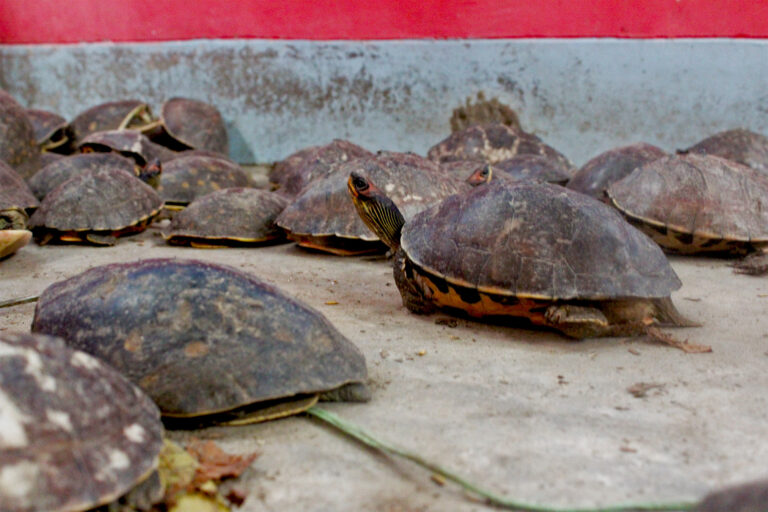- The Bangladesh Forest Department recently confiscated a large shipment of freshwater turtles from smugglers in the capital city.
- Experts say the consumer base for freshwater turtles is expanding in Bangladesh and attribute the raise in demand to the increasing foreign residents, mainly from East Asia, who are employed in the country’s infrastructural development projects.
- Conservationists warn that if the freshwater turtle trade is not controlled, it could drive multiple turtle species to extinction.
On Dec. 28, 2024, wildlife inspectors from Bangladesh’s Forest Department, following a tip-off, intercepted an intercity bus in Dhaka. They discovered two crates full of live turtles in the luggage compartment.
The bus operators stated that the consignment was destined for Sherpur in the northern district of Bogura, approximately 270 kilometers (168 miles) from the Comilla Highway (N114), where it was loaded. “Every day, similar consignments are transported along this route,” said Siddikul Islam, the bus driver.
Following the raid, on Dec. 30, the wildlife inspectors tracked down a temporary turtle storage warehouse in a wet market in Chandpur, a riverine district neighboring Comilla. There, they reportedly confiscated 1,300 live freshwater turtles, together weighing 280 kilograms (617 pounds). All three species they found — the Indian roofed turtle (Pangshura tecta), the Indian eyed turtle (Morenia petersi) and the Indian flapshell turtle (Lissemys punctata) — are protected species under Bangladesh’s Wildlife (Conservation and Protection) Act, 2012.
Earlier, on Dec. 10, the Forest Department had raided another temporary storage warehouse in Chandpur and seized 800 kg (1764 lbs.) of turtles belonging to the same three freshwater species.
Sanaullah Patwary, director of the Forest Department’s Wildlife Crime Control Unit (WCCU), said he was gravely concerned. He told Mongabay that the confiscation of such large quantities of smuggled turtles within just 20 days indicates an alarming expansion of the illegal turtle trade in Bangladesh.
Despite a ban on turtle trading in the country since 1998, the hunting and smuggling of freshwater turtles have persisted, catering to limited local consumption and illicit trafficking to neighboring India. However, the smuggling routes, particularly those connecting the sourcing locations to other distant parts of the country, have raised speculation on a bigger threat.
“Many foreigners are in Bangladesh working on mega infrastructure projects. We suspect that their demand for turtle meat may have contributed to this increase,” Sanaullah said.


Market expands amid new consumers
Bangladesh, crisscrossed by hundreds of rivers and dotted with water bodies such as canals, streams, estuaries, beels (lake-like wetlands), ponds and pools, provides diverse habitats for freshwater wildlife.
Available studies suggest that professional hunting groups catch turtles from the waterbodies and their nests and store them in temporary warehouses before transporting them to Dhaka and a few other districts.
The wildlife inspectors said a group of smugglers linked to professional hunters has been operating this illegal trade from the raided places for years under the guise of farming and trading swamp eels (Synbranchidae).
Some ethnic communities in Bangladesh consume turtle meat as part of their traditional festive diet. Additionally, turtle meat is sold in certain upscale areas of Dhaka where foreign residents live.
A 2013 study highlighted the common destinations for live turtle supply in Bangladesh — Dhaka, Narayanganj, Narsingdi, Gopalganj and Madaripur.
On Dec. 28, the smugglers were transporting the turtles to Sherpur in Bogura via Dhaka. Sherpur is a key junction for regional road connections to the northern districts such as Rangpur and Dinajpur, where Chinese firms are engaged in various developmental projects, including road construction.
Meanwhile, the nearby Pabna district hosts a significant Russian workforce involved in building the country’s first nuclear power plant.
“Given the presence of foreigners in northern and other parts of Bangladesh, we suspect the market of turtle meat has expanded. We have preliminary evidence that live turtles and trophies, including carapaces, are being smuggled to India from northern border districts,” said Ashim Mallick, one of the wildlife inspectors at WCCU.

Pushing freshwater turtles toward extinction
The 2013 study also identified certain freshwater turtle species that are frequently traded, all of which are currently globally threatened under to the IUCN Red List — the endangered Ganges softshell turtle (Nilssonia gangeticus), the endangered spotted pond turtle (Geoclemys hamiltonii), the endangered Indian eyed turtle (Morenia petersi), the endangered Indian roofed turtle (Pangshura tecta) and the vulnerable peacock softshell turtle (Aspideretes hurum).
A study in 1990 found regular trade of some freshwater turtles including the narrow-headed softshell turtle (Chitra indica), northern river terrapin (Batagur baska), Sylhet roofed turtle (Pangshura sylhetensis) and the Brahminy river turtle (Hardella thurjii). All four species were categorized as critically endangered or endangered in IUCN’s 2015 Red List of Bangladesh.
The 2015 Red List assessed 30 Testudines in Bangladesh, categorizing 22 species as threatened and four as near-threatened.
Shafique Haider Chowdhury, a retired zoology professor at Bangladesh’s Chittagong University and a technical reviewer of the 2015 Red List, warns that habitat loss and hunting for the meat market could push even currently stable turtle populations into threatened categories.
Freshwater turtles in Bangladesh are primarily aquatic, coming ashore only to lay eggs. Most are omnivorous or carnivorous, and some even scavengers, playing a vital role in maintaining ecological balance.
Shafique said he’s concerned that, while Indian roofed turtles and spotted flapshell turtles were assessed as ‘least concern’ in the 2015 Red List of Bangladesh, unchecked smuggling could soon move them into threatened categories.
“It would not be surprising if the next Red List, expected to start assessment in late 2025, categorizes all remaining turtle species [in Bangladesh] as threatened,” he said.
Sanaullah noted that commercial fish farming has destroyed much of the habitat for turtles and other crucial aquatic species in Bangladesh, particularly in the northern regions. He said, “We need support from civic groups to stop turtle smuggling. Otherwise, these species will become extinct.”
Banner image: Seized live turtles belonging to Pangshura tecta, Morenia petersi and Lissemys punctata species temporarily sheltered at the Forest Department enclosures before releasing them into the wild again. Image by Sadiqur Rahman.
Elite appetite turns Bangladesh from source to consumer of tiger parts
Citations:
Das, I. (1990). The trade in freshwater turtles from Bangladesh. Oryx. 24. 163 – 166. doi:10.1017/S0030605300033895
Shamsurrahman, M., Mamun, A., Rahman, M., Hossain, M. B., Minar, M. H., Maheen, N. J. (2013). Illegal Marketing of Freshwater Turtles and Tortoises in Different Markets of Bangladesh. American-Eurasian Journal of Scientific Research 8(1): 15-23. doi:10.5829/idosi.aejsr.2013.8.1.66124








